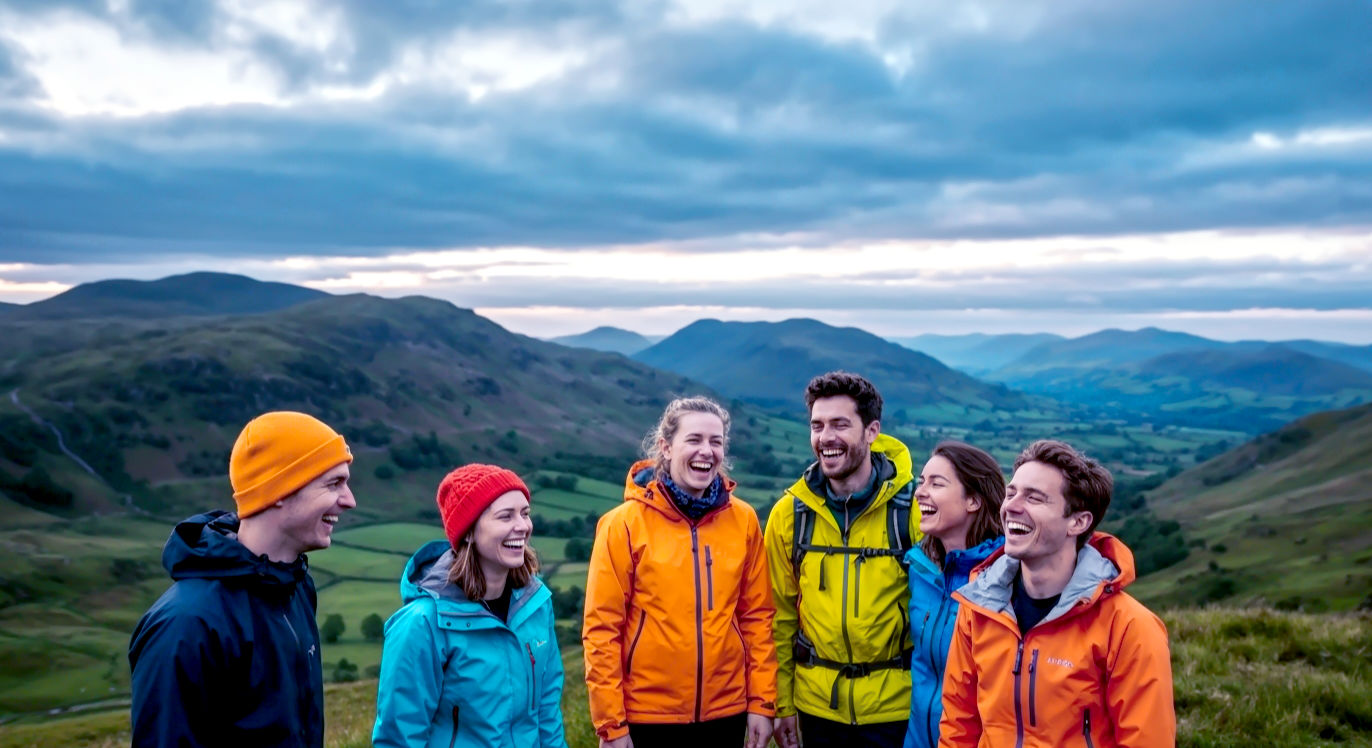The Guide to Action Hobbies: Adventure, Adrenaline, and the Great Outdoors
Your complete guide to the UK’s best action hobbies. Explore thrilling land, water, and air-based activities and find practical tips for starting your own adventure today.

This post may contain affiliate links. If you make a purchase through these links, we may earn a commission at no additional cost to you.
Ever felt that itch for something more? A pull away from the telly and towards the thrill of the unknown? You’re not alone. Deep down, many of us long for a bit of adventure—a proper challenge that gets the heart pumping and makes us feel truly alive. That, in a nutshell, is the world of action hobbies.
But what exactly are they? Think of them as pastimes with a bit of bite. They’re not about quietly collecting stamps or tending to a garden (though those are brilliant hobbies too!). Action hobbies are all about getting out there and doing something physical, exciting, and often, a little bit daring. They’re about pushing your limits, learning new skills, and seeing the world from a whole new perspective—whether that’s from the top of a mountain in the Peak District or from behind the wheel of a go-kart in Milton Keynes.
From the rugged coastlines of Cornwall to the dramatic peaks of the Scottish Highlands, the UK is a giant playground for adventure seekers. This guide is your ultimate starting point. We’ll dive into what makes an action hobby, explore the incredible variety on offer right here on our doorstep, and give you the practical tips you need to get started. So, grab a brew, get comfortable, and let’s explore the thrilling world of action hobbies.
What Makes a Hobby an “Action Hobby”?
So, what separates an action hobby from any other pastime? While there’s no strict rulebook, action hobbies generally share a few key ingredients. They’re the secret sauce that makes them so exciting and rewarding.
First and foremost, they’re physical. This doesn’t mean you need to be a super-fit athlete, but it does mean you’ll be moving your body. Whether it’s paddling a kayak down a gentle river or navigating a tricky climbing wall, you’ll be using your muscles and getting your blood flowing. It’s this physical element that often leaves you feeling tired but happy, with that satisfying ache of a day well spent.
Next up is the element of adventure and exploration. Action hobbies are rarely about staying in one place. They encourage you to get out and explore your surroundings. Think about mountain biking through a forest, discovering hidden trails and breathtaking views. Or coasteering along a stretch of coastline, exploring caves and coves you’d never see from the shore. It’s about embracing the journey and the thrill of discovery.
Then there’s the skill-based challenge. These hobbies aren’t something you can master overnight. They require you to learn new techniques, understand your equipment, and make smart decisions. Learning to read the wind while sailing or mastering the perfect paddle stroke in a canoe takes time and practice. But that’s what makes it so rewarding. Every small improvement feels like a massive victory, and the sense of accomplishment you get from mastering a new skill is hard to beat.
Finally, many action hobbies involve a degree of managed risk. This might sound scary, but it’s actually a key part of the appeal. It’s not about being reckless; it’s about learning to assess a situation, understand your own limits, and make safe choices. Whether it’s checking the weather before a hike or learning how to fall safely while skateboarding, managing risk builds confidence and self-reliance. It’s the tingle of adrenaline that comes from stepping just outside your comfort zone, knowing you have the skills to handle it.
Put these ingredients together, and you have the recipe for an action hobby: a physical, adventurous, and skillful pursuit that challenges you, builds your confidence, and connects you with the great outdoors.
Land-Based Action Hobbies: Conquering the Terrain
When you think of adventure, you probably picture rugged landscapes, muddy trails, and wide-open spaces. The UK is blessed with an incredible variety of terrain, making it the perfect place to explore land-based action hobbies. From gentle hills to challenging mountains, there’s something for every level of fitness and daring.
Hiking and Mountaineering: A British Classic
Let’s start with a true British classic: hiking. It’s the simplest of action hobbies, yet one of the most rewarding. All you need is a decent pair of boots and a sense of adventure. The beauty of hiking is that it can be whatever you want it to be. A gentle Sunday stroll through the New Forest, a challenging multi-day trek along Hadrian’s Wall, or a tough scramble up Scafell Pike—the choice is yours.
Mountaineering takes hiking to the next level. It’s about tackling more challenging peaks, often in winter conditions, and requires more specialised skills and equipment. Think ice axes, crampons, and ropes. It’s a serious pursuit, but the rewards are immense. Standing on a snow-dusted summit in the Cairngorms, with the world stretching out below you, is an experience you’ll never forget.
- Getting Started: The best way to start hiking is to join a local walking group like the Ramblers. They offer guided walks for all abilities and are a great way to meet like-minded people. For mountaineering, it’s essential to get proper training. Organisations like the British Mountaineering Council (BMC) offer courses for beginners.
- UK Hotspots: The UK is a hiker’s paradise. The Peak District, the Lake District, Snowdonia, and the Scottish Highlands are all world-class destinations.
Rock Climbing and Bouldering: Reaching New Heights
If you fancy a more vertical challenge, rock climbing could be for you. It’s a fantastic full-body workout that also tests your problem-solving skills. The aim is to find a route up a rock face, using your hands and feet to navigate the holds. It’s like a physical puzzle, and the feeling of reaching the top is incredible.
Bouldering is a form of climbing on smaller rocks or indoor walls without ropes. Because you’re not climbing as high, you use crash pads for safety instead. It’s a very social and accessible way to get into climbing, with indoor bouldering gyms popping up in towns and cities all over the country.
- Getting Started: The safest way to start is at an indoor climbing wall. You can hire all the gear you need and take an introductory course to learn the basics of safety and technique.
- UK Hotspots: The Peak District is famous for its gritstone edges, making it a climber’s mecca. Other great spots include the sea cliffs of Pembroke in Wales and the dramatic mountains of Glen Coe in Scotland.
Mountain Biking: Thrills on Two Wheels
For those who like their adventure with a side of speed, mountain biking is hard to beat. It’s all about riding bikes off-road, on everything from gentle forest tracks to steep, technical downhill trails. It’s a thrilling way to explore the countryside and get a serious workout at the same time.
There are several different styles of mountain biking. Cross-country (XC) is about covering long distances, with a mix of uphill and downhill riding. Trail riding is the most popular form, focusing on flowing singletrack trails with fun features like berms and small jumps. Downhill is for the adrenaline junkies, involving high-speed descents on purpose-built tracks.
- Getting Started: You don’t need a super-expensive bike to start. A decent hardtail (a bike with front suspension only) is a great entry point. Many trail centres offer bike hire, so you can try it out before you commit.
- UK Hotspots: The UK has some of the best trail centres in the world. Coed-y-Brenin and BikePark Wales in Wales are legendary, while Glentress and Fort William in Scotland attract riders from all over the globe.
Caving and Potholing: Exploring the Underworld
If you’re not afraid of the dark and confined spaces, caving (or potholing, as it’s often called in the north of England) offers a truly unique adventure. It involves exploring natural cave systems, navigating through underground passages, and discovering incredible subterranean landscapes. You’ll see stunning rock formations, vast chambers, and underground rivers—a hidden world that few people ever get to experience.
Caving is a team activity and requires a good level of fitness and a cool head. It can be physically demanding, involving crawling, climbing, and sometimes even abseiling. But for those with an adventurous spirit, it’s an unforgettable experience.
- Getting Started: Caving is not something you should ever try on your own. The best way to start is by joining a local caving club. They’ll have all the necessary equipment and experienced leaders who can teach you the ropes safely.
- UK Hotspots: The Yorkshire Dales is the UK’s premier caving destination, with a vast network of cave systems. The Mendip Hills in Somerset and the Brecon Beacons in Wales are also popular spots.
Water-Based Action Hobbies: Making a Splash
There’s something magical about being on, in, or near the water. It can be calm and serene one moment, and wild and powerful the next. The UK, as an island nation, is the perfect place to embrace water-based action hobbies. With thousands of miles of coastline, countless rivers, and beautiful lochs and lakes, the opportunities for aquatic adventure are endless.
Kayaking and Canoeing: Paddling Your Own Adventure
Kayaking and canoeing are two of the most popular ways to explore our waterways. While the terms are often used interchangeably, there is a difference. In a kayak, you sit with your legs out in front and use a double-bladed paddle. In a canoe, you typically kneel and use a single-bladed paddle.
Both offer a fantastic way to experience nature from a different perspective. You can paddle peacefully along a canal, navigate the gentle currents of a river, or take on the challenge of sea kayaking along our stunning coastline. For the more adventurous, whitewater kayaking offers the thrill of tackling rapids and fast-flowing rivers.
- Getting Started: Joining a local canoe and kayak club is a great way to start. They’ll provide coaching and equipment, and you’ll be able to paddle in a safe and friendly group. British Canoeing is the national governing body and a great resource for finding a club near you.
- UK Hotspots: The rivers Wye and Severn are perfect for gentle touring. For sea kayaking, the coastline of Pembrokeshire and the west coast of Scotland are hard to beat. For whitewater thrills, the River Tryweryn in North Wales offers year-round paddling.
Surfing and Bodyboarding: Riding the Waves
For many, surfing is the ultimate action hobby. The feeling of catching a wave and riding it towards the shore is pure joy. It’s a challenging sport that requires balance, strength, and an understanding of the ocean, but the rewards are addictive.
Bodyboarding is a great alternative for those who find standing up on a surfboard a bit tricky. You lie on a shorter, wider board, which makes it easier to catch waves and get a feel for the power of the ocean. It’s a super fun and accessible way to enjoy the surf.
- Getting Started: The best way to learn is by taking a lesson from a certified surf school. They’ll teach you the basics of water safety, how to paddle, and how to catch waves in a safe environment.
- UK Hotspots: Cornwall and North Devon are the heart of the UK surf scene, with world-famous beaches like Fistral and Croyde. The Gower Peninsula in Wales and Thurso in Scotland also offer fantastic waves.
Sailing and Windsurfing: Harnessing the Power of the Wind
Sailing is a timeless adventure that combines the thrill of being on the water with the challenge of working with the elements. Whether it’s a small dinghy on a local reservoir or a larger yacht exploring the coastline, sailing teaches you about the wind, the tides, and the sea. It can be a relaxing way to spend a summer’s afternoon or an exhilarating race against other boats.
Windsurfing adds a bit more adrenaline to the mix. It’s a combination of surfing and sailing, where you stand on a board and use a sail to catch the wind. It’s a fast and dynamic sport that’s a fantastic workout for your core muscles.
- Getting Started: The Royal Yachting Association (RYA) is the place to go for sailing and windsurfing courses. They offer a structured learning programme that will take you from complete beginner to competent sailor.
- UK Hotspots: The Solent, on the south coast of England, is a world-renowned sailing destination. The Lake District offers stunning scenery for dinghy sailing, while places like Weymouth and Portland Harbour are perfect for windsurfing.
Coasteering: A Coastal Obstacle Course
Coasteering is a uniquely British invention and one of the most exciting ways to experience our coastline. It’s a mixture of wild swimming, low-level climbing, scrambling, and cliff jumping, all done under the guidance of a qualified instructor. You’ll explore sea caves, traverse rocky ledges, and take on exhilarating jumps into the sea. It’s a full-body adventure that will leave you buzzing with adrenaline.
- Getting Started: Coasteering is something you should only ever do with a reputable, licensed operator. They will provide all the necessary safety equipment, including a wetsuit, helmet, and buoyancy aid, and their expert guides will ensure you have a safe and thrilling experience.
- UK Hotspots: Pembrokeshire in Wales is the birthplace of coasteering and remains one of the best places in the world to do it. The coastlines of Cornwall, Dorset, and the Isle of Skye also offer fantastic coasteering adventures.
Air-Based Action Hobbies: Taking to the Skies
For the ultimate thrill, nothing beats leaving the ground behind and taking to the skies. Air-based action hobbies offer a perspective on the world that few get to experience. The feeling of freedom and the breathtaking views are simply unmatched. While they often require more investment in terms of time and money, the payoff is an adventure like no other.
Paragliding and Hang Gliding: Soaring Like a Bird
Have you ever watched a bird effortlessly soaring on the wind and wished you could do the same? Paragliding and hang gliding are the closest you can get to that feeling. Both sports involve launching yourself from a hillside and using a large wing to ride thermal air currents, allowing you to stay airborne for hours and cover long distances.
A paraglider is a soft, fabric wing that inflates to create its shape, while a hang glider has a rigid frame. Paragliding is generally easier to learn and the equipment is more portable, but both offer an incredible sense of freedom and tranquillity.
- Getting Started: This is another hobby where professional training is non-negotiable. The British Hang Gliding and Paragliding Association (BHPA) oversees all training in the UK. You’ll need to complete a course with a BHPA-registered school to get your license.
- UK Hotspots: The South Downs in Sussex, the Brecon Beacons in Wales, and the Peak District are all popular spots for flying, offering reliable winds and stunning scenery.
Skydiving: The Ultimate Leap of Faith
For the ultimate adrenaline rush, it’s hard to look past skydiving. Jumping out of a plane at 10,000 feet and freefalling at over 120 mph is an experience that will stay with you forever. After the intense thrill of freefall, the parachute opens, and you get to enjoy a peaceful descent back to earth, taking in the incredible bird’s-eye view.
- Getting Started: The most common way to experience skydiving for the first time is with a tandem jump. You’ll be securely strapped to an experienced instructor who takes care of everything, allowing you to simply enjoy the ride. If you get bitten by the bug, you can go on to do an Accelerated Freefall (AFF) course to become a licensed skydiver.
- UK Hotspots: There are skydiving centres (known as drop zones) all over the country. Some of the most popular are located in Wiltshire, Lincolnshire, and Perthshire in Scotland.
Gliding: The Art of Silent Flight
If the noise and speed of skydiving aren’t for you, gliding offers a more serene way to experience the skies. Gliders, or sailplanes, are aircraft without engines. They are towed into the air by a powered plane or launched by a winch, and then they fly by finding rising currents of air, much like a paraglider.
Gliding is a wonderfully graceful and peaceful way to fly. The silence in the cockpit is broken only by the sound of the wind, and you can spend hours soaring over the countryside, enjoying the views and the challenge of staying airborne.
- Getting Started: The British Gliding Association (BGA) is the governing body in the UK. Joining a local gliding club is the best way to get started. Most clubs offer trial lessons and fixed-price courses to get you flying solo.
- UK Hotspots: Gliding clubs can be found all over the UK, often located in rural areas with plenty of open airspace. The Cotswolds, the Yorkshire Moors, and the area around the Malvern Hills are all fantastic places to glide.
Getting Started: Your Action Hobby Journey
Feeling inspired? Taking that first step into a new action hobby can feel a bit daunting, but it’s easier than you might think. With a bit of planning and the right attitude, you’ll be on your way to a new adventure in no time.
Finding the Right Hobby for You
The first step is to figure out which hobby is the right fit for you. Think about what you enjoy and what you want to get out of a new pastime.
- What’s your budget? Hobbies like hiking can be started with minimal cost, while activities like skydiving or gliding require a more significant investment. Be realistic about what you can afford.
- How much time can you commit? Some hobbies, like bouldering at a local gym, can be done in a couple of hours. Others, like mountaineering or sailing, often require a full day or even a weekend.
- What’s your fitness level? Be honest with yourself. While many hobbies can be adapted to different fitness levels, some are naturally more demanding than others. The good news is that whatever you choose, you’ll get fitter as you do it!
- Do you prefer to be solo or in a group? Some people love the solitude of a long hike, while others thrive on the social aspect of a climbing club or a sailing crew.
The Importance of Taster Sessions and Beginner Courses
Once you have an idea of what you’d like to try, the best thing you can do is book a taster session. Nearly every action hobby offers some form of introductory experience, whether it’s a guided hike, a beginner’s climbing course, or a tandem skydive.
Taster sessions are brilliant for a few reasons. They let you try out the activity in a safe and controlled environment, under the guidance of experienced instructors. You’ll be able to use their equipment, so you don’t have to splash out on your own gear before you know if you like it. And most importantly, they give you a real feel for the hobby, helping you decide if it’s something you want to pursue further.
Joining a Club: The Social Side of Adventure
If you decide to take a hobby further, joining a club is one of the best things you can do. Clubs are the heart and soul of the action hobby community in the UK. They’re run by passionate volunteers and offer a friendly and supportive environment for beginners.
Joining a club has tons of benefits. You’ll get access to affordable coaching, be able to use club equipment, and have a ready-made group of people to go on adventures with. It’s also a fantastic way to make new friends who share your passion. You’ll find that the social side of these hobbies is often just as rewarding as the activity itself.
Staying Safe: The Golden Rules of Adventure
Action hobbies, by their very nature, come with some level of risk. But that doesn’t mean they’re dangerous. The key is to be smart, be prepared, and always respect the environment you’re in.
- Get the right training. For technical hobbies like climbing, kayaking, or paragliding, professional instruction is essential. Don’t try to teach yourself from a YouTube video.
- Have the right gear. Make sure your equipment is well-maintained and suitable for the activity. And know how to use it properly.
- Check the weather. The British weather is famously unpredictable. Always check the forecast before you head out and be prepared for conditions to change.
- Know your limits. Don’t be afraid to turn back if you’re feeling tired, the weather is turning, or something just doesn’t feel right. The mountains and the sea will still be there tomorrow.
- Tell someone your plans. Always let someone know where you’re going and when you expect to be back.
The Future of Action Hobbies: Trends and Innovations
The world of action hobbies is constantly evolving. New technology, changing attitudes, and a growing appreciation for the outdoors are shaping the future of adventure.
One of the biggest trends is the rise of electric-powered equipment. E-bikes are making mountain biking more accessible to people of all fitness levels, allowing them to tackle longer rides and steeper hills. Electric surfboards and hydrofoils are opening up new possibilities for watersports, even in places without waves.
Technology is also playing a bigger role in safety and navigation. GPS devices and smartphone apps have made it easier than ever to plan routes and call for help in an emergency. Drones are being used to capture stunning footage of our adventures and even to help with mountain rescue.
There’s also a growing awareness of the importance of sustainability. More and more people are looking for ways to enjoy the outdoors without harming it. This has led to a greater emphasis on “leave no trace” principles and a rise in eco-conscious adventure travel.
Ultimately, though, the future of action hobbies is about the same thing it has always been: people pushing their boundaries, connecting with nature, and discovering what they’re capable of. As long as there are mountains to climb, waves to surf, and skies to explore, there will be people seeking adventure.
So, what are you waiting for? Your next great adventure is out there. It’s time to take the first step.
Further Reading and Resources
- The British Mountaineering Council (BMC): The representative body for climbers, hill walkers, and mountaineers in England and Wales. https://www.thebmc.co.uk
- British Canoeing: The national governing body for canoeing and kayaking in the UK. A great resource for finding clubs and courses. https://www.britishcanoeing.org.uk
- The Royal Yachting Association (RYA): The UK’s national body for all forms of boating, including dinghy and yacht racing, motor and sail cruising, and windsurfing. https://www.rya.org.uk
- British Cycling: The home of cycling in Great Britain, with plenty of information on getting into mountain biking. https://www.britishcycling.org.uk
- Surfing England: The recognised National Governing Body for the Sport of Surfing in England. https://www.surfingengland.org
- The British Hang Gliding and Paragliding Association (BHPA): The governing body for hang gliding and paragliding in the UK. https://www.bhpa.co.uk






